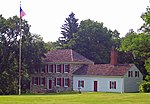New Windsor Cantonment State Historic Site
American Revolution on the National Register of Historic PlacesAmerican Revolutionary War museums in New York (state)American Revolutionary War sitesBuildings and structures in New Windsor, New YorkMuseums in Orange County, New York ... and 6 more
National Register of Historic Places in Orange County, New YorkNew Windsor, New YorkNew York (state) historic sitesNew York (state) in the American RevolutionPalisades Interstate Park systemTourist attractions in Orange County, New York

The New Windsor Cantonment State Historic Site, also known as New Windsor Cantonment, is located along NY 300, north one mile of Vails Gate, in the Town of New Windsor, Orange County, New York. The site features a reconstruction of the Continental Army's final military encampment.
Excerpt from the Wikipedia article New Windsor Cantonment State Historic Site (License: CC BY-SA 3.0, Authors, Images).New Windsor Cantonment State Historic Site
Temple Hill Road,
Geographical coordinates (GPS) Address Nearby Places Show on map
Geographical coordinates (GPS)
| Latitude | Longitude |
|---|---|
| N 41.472777777778 ° | E -74.06 ° |
Address
Temple Hill Road 370
12553
New York, United States
Open on Google Maps










